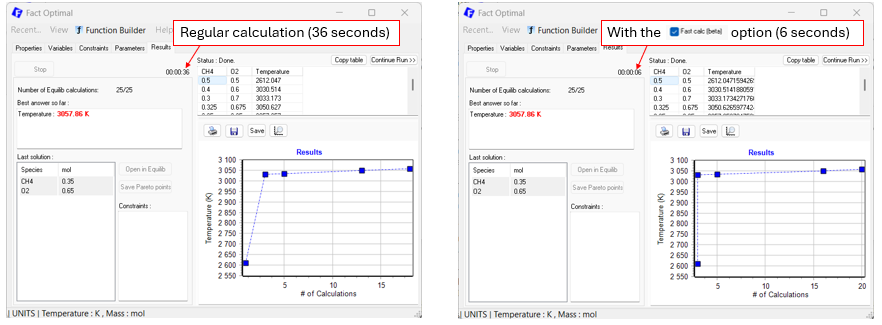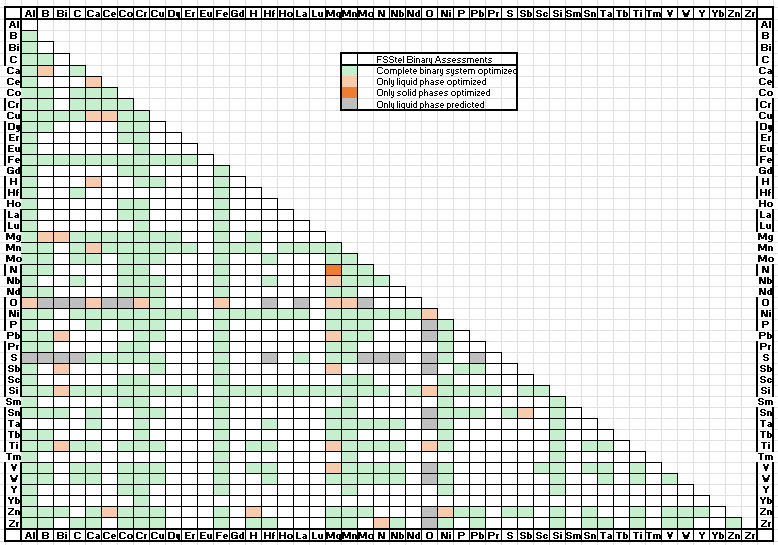- About Window
When FactSage 8.4 is being loaded and the About Window is displayed, a message is posted informing users about expiration dates of the license and databases and disappears after 10 seconds. The message can be posted again by clicking on 'About' in the FactSage Main menu window.

- Start-up apps and batch files
This was first introduced in FactSage 8.3. You can load and run other apps (executable .exe and batch .bat files) immediately after startup when FactSage has loaded and the FactSage Menu Window is displayed.
For example after startup you could run Welcome.exe and RunMeFirst.bat
- Welcome.exe - an executable file you have written to say to post a welcome message or give new users instructions, etc.
- RunMeFirst.bat - a batch file you have written to say refresh files or delete files, etc.The commands to do this are the following two lines stored in the text file \Add-ons_Apps\Add-ons_Apps.dat
;Welcome.exe /STARTUP; ; Executable file to run at start-up; ; ;RunMeFirst.bat /STARTUP; ; Batch file to run at start-up; ;
Details are presented elsewhere in Add-ons, apps and shortcuts in FactSage 8.4 .
In the FactSage 8.3 Main Menu Window click
If you are entitled to FactSage 8.4 the file CD-FactSage84.exe (approx. size 450 MB)
will be downloaded to the downloads folder.
Typically this takes 10 - 20 minutes or even longer.
2. Download via www.factsage.com
For details visit www.factsage.com
and click 'Download Service' and then 'FactSage 8.4 Update/Installation'.
FactSage dongle status
- When a valid FactSage dongle is attached to a USB port on the computer you are able to run a standalone version
of FactSage.
If FactSage issues an error message about a 'missing or invalid FactSage security key'
it goes into the FactSage SetUp mode with a green screen.
There are several factors that can cause this to happen.
The 'FactSage dongle status' Window shown here is for an installation where a valid FactSage dongle
is attached and everything is in order (i.e. 1 - 5. All OK).
The FactSage 8.4 Installation program enables you to update/refresh FactSage 8.4 software,
documentation and databases to the full FactSage 8.4 package.
You can upgrade FactSage 8.0 - 8.3 to FactSage 8.4 but
you must not upgrade any FactSage 7.0 - 7.3
currently installed on your computer.
You can update/refresh a FactSage Standalone computer or a Network
Server. In the case of a network installation it is
only necessary to update/refresh the Network Server.
If your computer has access to the Internet you can use FactSage 8.4 to download and update various
FactSage files from www.factsage.com.
Information on updates ...
- your computer has access to www.factsage.com
When you first run FactSage 8.4 the program tries to connect to www.factsage.com and check if
your installation has the latest Profiles84.ini.
If you have checked
All of these actions will be done automatically.
After updating the profiles file it is not necessary for you to quit FactSage and refresh the installation.
When you first run FactSage 8.4 the program tries to connect to www.factsage.com and check if
your installation has the latest special databases and patches.
If you have checked
When an important file is missing you will be made aware of the problem.
For more information on missing or blocked files refer to
Anti-virus software and firewalls
Several slide shows and applications have been added or updated, for example
The following important items were presented in FactSage 8.3.
This was first introduced in FactSage 8.2 to help new users get started with FactSage
and to help experienced users select the databases. It has been well-received and remains unchanged.
For more details refer to
FactSage 8.2 - getting started.
In FactSage 8.4 the total number of stored phase diagrams has been increased by over 300.
View Data has been modified so that the 'Summary' drop down menu
can list the species by virtual element.
For more details click
Virtual Elements
The virtual elements provide a useful means of applying constraints to certain
equilibrium calculations as presented in
Virtual Elements - Equilib and
Virtual Elements - Phase Diagram.
ViewData of the FTionx compound database
with the 'Summary' drop down menu listing the species with virtual elements.
.
This was first introduced in FactSage 8.3 and it works well.
With the FactSage Add-ons menu it is possible to run multiple instances
(i.e. copies of the software) of Equilib.
That is, it is possible to have separate copies of Equilib running simultaneously but independently from each other.
For more details refer to
Add-ons, apps and shortcuts in FactSage 8.4 .
This new feature in FactSage 8.4 enables you to select and define the composition of an industrial grade alloy of
aluminum, copper, magnesium, etc.
Details are given in the Equilib - Advanced Features Slide Show in the new section 16
Selection of an Industrial Grade Alloy (pdf file)
In the Equilib Reactants Window click 'Edit > Select an Alloy Grade ...'
to display the Alloy Grades Window.
Then select the alloy, for example Copper alloys, then the grade (brass, bronze , casting ...) and finally define the composition.
When defining the composition of the alloy a Help panel is posted.
For example, in the aluminum 2024 grade alloy above the wt.% Mn 5 is highlighted
because the composition is outsde the recommended range 0.3 - 0.8 wt.% Mn.
When editing is finished you must decide if you want this composition grade to be saved as a "mixture"
(*.mixt file) which can then be imported in the "Reactants Window" at any time.
If the compostion is not saved as a "mixture" it will be simply imported into the "Reactants Window"
as the reactants listed here.
Also you must decide if you wish to include 0 wt% elements (Cr, Si, Ti, Zn) in the list of element compositions.
When ready click on "OK" to save the system or click "Cancel" to quit.
When done you will returned to the Reactants Window.
The link
What's New in Macro Processing
has been updated and gives a summary of the more important programming changes in
Macro Processing that have appeared since FactSage 6.1 (2009)
until now FactSage 8.4 (2025).
In FactSage 8.4 a new Macro Editor is available.
The editor includes the traditional File (Open, Open recent, Save, Save as, etc.)
and Edit (Undo, Copy, Paste, Fine, Find next, etc.) drop down menus.
With the Macro Editor the macro commands, functions and varibles are displayed in a variety of colors selected by the user.
This much improves the readability of the macro and interpretation of the program flow.
In addition there is the option to Run Macro without having to exit the editor.
For more details consult the
- Macro Editor Slide Show.
- which has been updated in FactSage 8.4.
This was first introduced in FactSage 8.3 and works well.
With the FactSage Add-ons menu it is possible to run multiple instances
(i.e. copies of the software) of Phase Diagram.
That is, it is possible to have separate copies of Phase Diagram running simultaneously but independently from each other.
For more details refer to
Add-ons, apps and shortcuts in FactSage 8.4 .
In FactSage 8.4 there are two database optimization apps:
OptiSage, the legacy module that was developed in the early 2000's,
and Calphad Optimizer, a new module that has been completely re-written to meet current industry standards and user needs.
As already possible in OptiSage, Calphad Optimizer is meant for the assessment of Gibbs energy data.
Various types of experimental data (phase diagram, enthalpy, activity data etc.) can be utilized in order
to generate optimized parameters for the Gibbs energies of stoichiometric compounds as well as the excess
coefficients of a wide range of non-ideal solution models
With the modern GUI provided by Calphad Optimizer, it has become even easier to generate and organize
different experimental data groups, select the thermodynamic parameters, as well as deploy and monitor the
optimization with instant plots of the current best fit.
Beyond that, with the most recent version of Calphad Optimizer for FactSage 8.4, a major development has been incorporated.
Now, the error sum, which is used as a target by the optimization algorithm, has been extensively reformulated
to compute measured variables directly related to the Gibbs energy of phases being optimized.
This makes the thermodynamic parameter space a lot smoother to navigate, and a lot less sensitive to the starting
values provided by the assessor.
As a result, the new version of Calphad Optimizer enables single-shot, reproducible, and effective
optimizations without user interference. A complete report about this major achievement and its implications
is published as a paper
Calphad Optimizer 2.1.0 is released with FactSage 8.4. For latest news on the improvements and
enhancements visit Calphad Optimizer - What's new?.
Note: The Calphad Optimizer is not included with the standard FactSage installation because it still
has a more frequent update cycle than FactSage.
The next update is planned in autumn 2025. To download the package (200 MB), simply try starting Calphad Optimizer
from the FactSage main menu and follow the instructions.
Add-ons are not part the regular FactSage package but rather are additional Apps that are offered for free to standalone users who have current Maintenance and Service, M&S.
Access to the Add-ons is only available while the M&S is valid.
That is, access to the Add-ons will not be available when the M&S has expired, although a grace period of a few months may be added.
Access to the Add-ons is not available to client or server network installations.
- in the FactSage 8.4 Main Menu Window click 'Add-ons > FactFlow process simulation ...'
Traditionally, these stream-related tasks were sequentially performed in the Equilib module often employing macro processing.
This is time-consuming and difficult to automate.
For these reasons, we implemented the powerful graphical interface called FactFlow which allows one to fully exploit the FactSage databases.
For detailed information refer to
The screenshots below illustrate four pyrometallurgical processes which have been built using the FactFlow interface.
For more information please contact Prof. J.P. Harvey (j-p.harvey@polymtl.ca)
or email the FactFlow team at factflow@polymtl.ca
- in the FactSage 8.4 Main Menu Window click 'Add-ons > FactProSim process simulation ...'
FactProSim, a new platform for process simulation provided with FactSage 8.4, is designed to assist the development of process
simulations based on the local equilibrium concept using the Effective Equilibrium Reaction Zone (EERZ) model.
FactProSim uses an intuitive flowsheet diagram approach to model the process with modules, which interact with
each other through the flow of materials. It is designed with a drag-and-drop approach, providing a user-friendly
interface with no coding required. FactProSim has four simple modules to create the process flowsheet of any complex reactor.
FactProSim offers the possibility to enter various inputs in the flowsheet modules (such as material composition,
amount and temperature, equilibrium calculation conditions, etc.) through spreadsheets by linking one or several
Microsoft Excel spreadsheets to a flowsheet. Furthermore, the output of the simulation is also saved in Microsoft
Excel spreadsheets to provide a convenient way to analyze and represent the output data.
Several flowsheet examples can be found in the folder \FactProSim\Projects.
Both FactFlow and FactProSim packages have access to the suite of FactSage databases.
For many years we wanted to develop a process simulation package that would provide a powerful interactive
graphical interface to replace Equilib and macro processing.
Two groups, one at the
CRCT, Montreal, Canada
and the other at the
High Temperature Thermochemistry Laboratory - Seoul National University, Korea
were eager to take on the challenge.
The huge difference in physical location and time of the day between the
two groups made a joint collaboration impossible.
Both packages have exceeded our expectations and
both are being promoted since each one offers a unique approach.
Here is a summary of the particular features of each package.
Both FactFlow and FactProSim:
In the FactSage Main Menu Window click Documentation for detailed information on the public compound and solution databases.
The following new options have recently been added to Data Search Window.
Private databases in \PRIVDATA
- this option, introduced in FactSage 8.3, applies to all private compound (*.cdb) and solution (*.sln,*.fdb) databases
that are stored in the \PRIVDATA folder (typically c:\FactSage\PRIVDATA).
These databases are automatically registered and added to the 'List of databases' posted in the Data Search Window.
The old manual way is still available (click 'Add/Remove Data > Add > filename etc.')
but storing the files in the \PRIVDATA folder avoids performing this manual task.
FTionx databases
- this option, new in FactSage 8.4, offers FTionx
- the new FACT Ionic Organics Databases
The FactPS 8.4
exclusion file has been updated.
The file is consulted when a given compound is listed in more than one database.
For example MgSnO3, Mg2SnO4, Na2S2O7, ... (see above) are oxides that have been added to
FactPS 8.4
and these compounds are also stored in FToxid.
When FactPS
and FToxid databases are selected, if a user selects say all solids in the Equilib Menu Window,
the exclusion file will avoid a duplicate selection by only selecting the FToxid compounds.
This is a simple example with oxides where the selection priority is obvious.
But when more than one FACT compound database is selected and it involves say metals, alloys, oxides, salts, etc.
there is a priority among competing databases that may not be not so evident.
This is where the exclusion file plays an important role in avoiding the duplicate selection of compounds.
In FactPS 8.4
there are 91 elements with a total of 5203 compounds (was 5038 in 8.3) and 7373 phases (was 7167).
In FactSage 8.4 the updates to FToxid include the following:
The FTsalt databases contain data for pure salts and salt solutions of 29 main cations:
and 15 main anions:
F, Cl, Br, I, NO2, NO3, ClO4, OH, CO3, SO4,
S2O7, CrO4, Cr2O7, MoO4, Mo2O7
as well as for dilute solutions of O2- and OH- in the molten salt phase.
In FactSage 8.4 the updates to FTsalt include the following
Also, compressibility expressions
(as a function of temperature) have been modified for the following pure liquid salts:
LiCl, NaCl, KCl, RbCl, CsCl, MgCl2, CaCl2, SrCl2, BaCl2, LiF, NaF, KF, RbF, CsF, MgF2,
CaF2, LiBr, NaBr, KBr, RbBr, CsBr, MgBr2, LiI, NaI, KI, RbI, CsI, Li2CO3, Na2CO3, K2CO3,
LiNO3, NaNO3, KNO3, RbNO3, CsNO3, Li2SO4, Na2SO4, K2SO4, LiOH, NaOH, and KOH.
In the solution FTsalt database new liquid solutions SALTN
(Na, K // Cl, CO3, SO4, S2O7, CrO4, Cr2O7, MoO4, Mo2O7, O - diluted in oxides),
SALTO (Na, K, Zn, Pb // Cl) and SALTP (Na, K, Hg, Hg2 // Cl) have been added.
In the case of SALTN, the model for the Na, K // Cl, CO3, SO4, S2O7 sub-system
is identical to that in the FTpulp database.
In addition seven new solid solutions have been introduced :
one pyrosulfate solid solution (KPyr), one pyrosulfate/dichromate solid solution
(Na2S2O7), two dichromate/dimolybdate solid solutions (K2Cr2O7 and Na2Cr2O7),
and three molybdate/chromate/sulfate solid solutions (K2MoO4(s3), Na2MoO4(s1)
and Na2MoO4(s2)).
Several solid solutions have been extended :
addition of the CrO4[2-] and MoO4[2-] anions to the solid solutions Dbeta-K2SO4,
alpha-K2SO4, Glaserite, and Na2SO4-V; addition of the CO3[2-] and MoO4[2-] anions
to the Na2CrO4 solid solution; and addition of the SO4[2-] anion to the solid
solutions gamma-Na2CO3 and beta-Na2CO3.
The SALTN (Na, K // Cl, CO3, SO4, S2O7, CrO4, Cr2O7, MoO4, Mo2O7,
O - diluted in oxides) liquid solution is the only FTsalt molten salt solution
containing A2MO4 and / or A2M2O7 (with A = Na, K and M = Cr, Mo).
The SALTO (Na, K, Zn, Pb // Cl) liquid solution is the only FTsalt molten
salt solution containing both ZnCl2 and PbCl2.
The SALTP (Na, K, Hg, Hg2 // Cl) liquid solution is the only FTsalt molten salt solution containing HgCl2.
The total number of stored FTsalt phase diagrams
is now 419 (was 377 in 8.3).
FTsalt 8.4
is included in the FACT 8.4 package of databases.
Complete details on FTsalt 8.4 including all the phase diagrams are given in
Documentation in the FactSage Main Menu Window.
The FTmisc databases contain data for a variety of sulfides, alloys, etc.
The databases includes dilute alloys of Fe-liquid, Pb-liquid, Sn-liquid, Cu-liquid, Cd-liquid, Te-liquid, Sb-liquid,
Se-liquid, SeTe-liquid, SbPb-liquid and PbSb-liquid each with a limited number of components, valid over limited composition ranges
In FTmisc 8.3
the MAT2 liquid sulfide/metal solution, and all solid solutions and stoichiometric compounds compatible was moved
to the new FTsulf 8.3 database.
For the matte smelting system (S-Cu-Fe-Ni-Co-Pb-Zn-As), the remaining sulfide solid solutions and stoichiometric compounds are compatible with liquid matte [FTmisc-MATT]. This system has been superseded by the new FTsulf 8.3 database, which provides equally good or better results for most applications.
In FTmisc 8.4 the liquid steel solution FTmisc-FeLq has been updated:
Complete details on FTmisc 8.4 including all the phase diagrams are given in Documentation.
The FTionx databases contain data for pure ionic organics compounds and ionic organic solutions of 8 cations:
with C3MIm = 1-propyl-3-methyl-imidazolium, C4MIm = 1-butyl-3-methyl-imidazolium,
C3MPip = 1-propyl-1-methyl-piperidinium, C3MPy = 1-propyl-3-methyl-pyridinium,
C3MPyrr = 1-propyl-1-methyl-pyrrolidinium, C4MPyrr = 1-butyl-1-methyl-pyrrolidinium,
C2Py = 1-ethyl-pyridinium, and C4Py = 1-butyl-pyridinium.
and 6 anions:
In FTionx 8.4 there are currently:
For normal equilibrium calculations all the compounds tend to decompose into C(graphite, s) and gaseous products.
In order to inhibit these decomposition reactions
in FactSage, "virtual elements" (Qa, Qb, ..., Qh) with atomic weights of 0.0 have been used.
The total number of stored FTionx phase diagrams is 22.
For example, the following phase diagrams are polythermal projections of the liquidus surface.
In FTlite 8.4 the changes are extensive.
A total of 1017 binary systems (was 992 in 8.3)
have been evaluated, for most of them over the entire range of composition and for all stable phases.
Several binary systems were revised.
A matrix of assessed binary systems is shown here
for the major and minor alloying elements of Al-, Mg- and Ti-alloys.
Several dozens of ternary systems have been assessed, and important quaternary systems have also
been evaluated.
FTlite 8.4 contains 324 solution phases (vs 317 in 8.3) and 2304 pure compounds
(was 2145 in 8.3) with 2806 stoichiometric phases counting allotropic forms (2621 in 8.3).
The total number of stored FTlite phase diagrams is now 1077 (was 1045 in 8.3).
Complete details on FTlite 8.4 including all the phase diagrams are given in the
updated Documentation in the FactSage Main Menu Window.
In addition, several dozens of ternary systems have been assessed, and important quaternary systems have also
been evaluated.
The FScopp 8.4 database contains 330 solution phases (269 in 8.3) and 1471 pure compounds
(1077 in 8.3) with 1891 stoichiometric phases (1442 in 8.3) counting allotropic forms.
Complete details on FScopp 8.4 including all the phase diagrams
are given in 'Documentation' in the FactSage Main Menu Window.
FSlead
is designed for thermodynamic and phase equilibrium calculations involving Pb alloys.
In FSlead 8.4 (27 elements) a total of 238 binary systems (235 in 8.3) have been evaluated,
for most of them over the entire range of composition and for all stable phases.
A matrix of assessed binary systems is shown here for the major and minor alloying elements of Pb-alloys.
In addition, several dozens of ternary systems have been assessed, and important quaternary systems have also been evaluated.
The FSlead 8.4 database contains 127 solution phases (125 in 8.3) and 434 pure compounds (415 in 8.3) with 641 stoichiometric phases (618 in 8.3) counting allotropic forms.
Complete details on FSlead 8.4
including all the phase diagrams are given in
'Documentation' in the FactSage Main Menu Window.
The FactSage 8.4 database contains 46 elements:
The FactSage FSstel steel database is based on relevant steel sub-systems from the
old SGTE Solution database, but now incorporates updates of those systems as well as new published assessments.
"Tramp elements" have also been included to allow calculations relating to recycling and removal of unwanted impurities to be performed.
FSstel contains 381 completely assessed 61 partially assessed binary alloy systems,
together with approximately 168 ternary and 29 quaternary systems for which assessed parameters are available for phases of practical relevance.
It contains 181 solution phases and 1015 stoichiometric compounds.
In FSstel the following systems have been added or updated.
(1) Updates
Update of Mu_phase and Sigma phase for binary and ternary systems
Mu_phase and Sigma phase form extensive solid solutions in the Fe-Co-Cr-Mn-Mo-Nb-Ni-Ta system,
which is important for high entropy alloys, and Ni- and Co-super alloy systems.
Mu_phase and Sigma phase in binary and ternary systems were updated for better description of phase diagrams.
In several ternary systems, FCC, BCC, liquid and other solutions were also updated simultaneously.
Co-Mo system: change of Mu_phase, Sigma phase, liquid phase
(b) Ternary systems
Co-Fe-Mo system: update of Mu_phase, Sigma, FCC, Liquid
(2) Hydrogen containing systems (Hydrogen solubility in V-rich BCC phase)
(3) FCC L12 and BCC B2 order phase
(4) Minor updates:
The total number of stored FSstel phase diagrams is 330.
Complete details on FSstel 8.4 including all the phase diagrams are given in 'Documentation' in the FactSage Main Menu Window.
The 79 elements included in the database are
96 binary systems and 12 ternary system have been added, and updates have been applied to 19 binary systems.
THe total number of phase diagrams is now 1363.
Complete details on SGTE(2024) with revised documentation and all the calculated
phase diagrams are given in Documentation in the FactSage Main Menu.
The elements included in SpMCBN are:
Al, Ca, Co, Cr, Fe, Hf, Mg, Mn, Mo, Nb, Ni, Re, Sc, Ta, Tc, Ti, V, W, Y, Zr
The SpMCBN database for FactSage 8.4 now includes nearly 100 new ternary systems. These relate to 33 systems with boron, 34 systems with carbon, 30 systems with nitrogen and 3 systems with silicon.
There are now 244 binaries and 712 ternaries that give a total of 956 phase diagrams stored in FactSage 8.4.
Complete details on SpMCBN 8.4 including all the phase diagrams are given in
Documentation in the FactSage Main Menu.9
What's New in:
The following are summaries of the more important programming changes in each release.
1. Download FactSage 8.4 via FactSage 8.3
For certain installations it may not be possible to download the file - for example you may get an
error message such as 'webpage cannot be found'.
This could be because the security settings on your computer are blocking the transfer of a ".exe" file
or the file is too large to be downloaded.
Check with your IT group.
Tools > FactSage Updates > Download the complete FactSage 8.4 Update/Installation Package .
Minimum System Requirements: Equivalent to the minimum system requirements for running Microsoft Windows 10 operating system.
Recommended System Requirements: Microsoft Windows 10 or above; CPU: Intel Core i7 2.8 GHz (or an equivalent AMD processor) or better: RAM: 16 GB or more: Storage: 7200 RPM or better HDD or SSD.
The FactSage dongle status displays the status of the FactSage dongle attached to the computer.
This helps you to diagnose the source of the error message.


In the FactSage Main Menu click Tools > FactSage Updates
to display the following options:
- for details on the following options
- to list the files that can be updated
- to update/refresh your FactSage 8.4 expiration dates
This avoids the necessity to manually download and install an updated Profiles84.ini.
(Note, this update operation can now be done automatically - see Automatically update Profiles84.ini below).
- this is no longer offered due to issues with anti-virus software and
firewalls.
- the most recent FactSage 8.4 Package (CD-FactSage84.exe)
with the latest profiles file, Profiles84.ini.
- this will be available after FactSage 8.4 has been released at a future date.
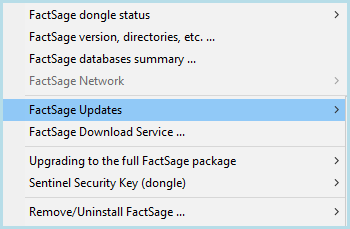
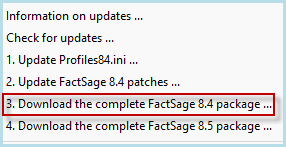
![]() Automatically update Profiles84.ini
Automatically update Profiles84.ini
- when necessary the latest Profiles84.ini is updated
and the FactSage 8.4 expiration dates are automatically refreshed.
Any new special database FSstel, FTlite, SpMCBN, etc. and dongle will be refreshed at the same time.
This is the recommended setting.
- in order to update Profiles84.ini you must first select
Check for updates ...
and then select 1. Update Profiles84.ini.
This setting is not recommended.
For the updating to succeed the following conditions must be satisfied:
- you are running FactSage 8.4 as a standalone or server installation i.e. not network client installation
![]() Automatically update Profiles84.ini the latest profiles file is downloaded and installed.
In such a case you are notified that the following operations will be performed:
Automatically update Profiles84.ini the latest profiles file is downloaded and installed.
In such a case you are notified that the following operations will be performed:
![]() Automatically update Profiles84.ini
the latest profiles file is downloaded and installed as shown above.
Automatically update Profiles84.ini
the latest profiles file is downloaded and installed as shown above.
However, if you have NOT checked
Automatically update Profiles84.ini
when necessary an 'Updates are ready.' message is posted in the FactSage Main Menu.

This was first introduced in FactSage 8.0 and has been updated.
Each time FactSage 8.4 is run a check is performed to make sure the important installation files (principally *.exe and *.dll)
have not been inadvertently deleted.
2. Apps:

The link What's New in View Data has been updated and
gives a summary of the more important programming changes in View Data that have appeared
since FactSage 6.1 (2009) until now FactSage 8.4 (2025).
The new FactSage 8.4 database FTionx
(see below)
contains compounds with virtual elements Qa, Qb ...
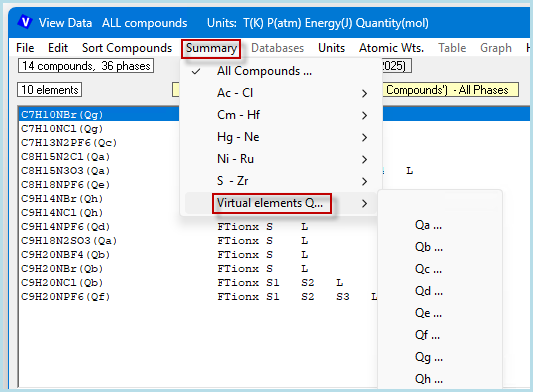
![]() Equilib
Equilib
The link
What's New in Equilib has been updated
and gives a summary of the more important programming changes in Equilib that have appeared
since FactSage 6.1 (2009) until now FactSage 8.4 (2025).

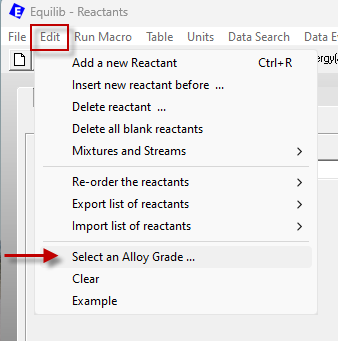
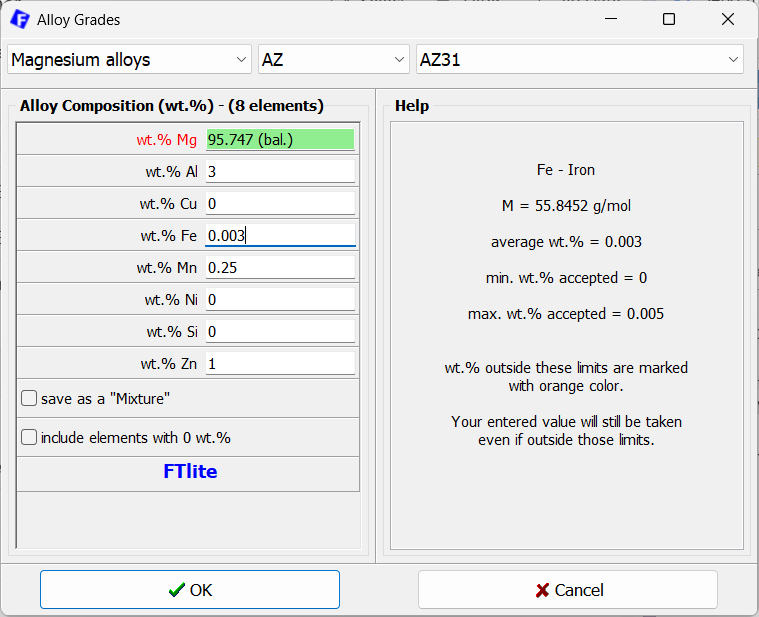
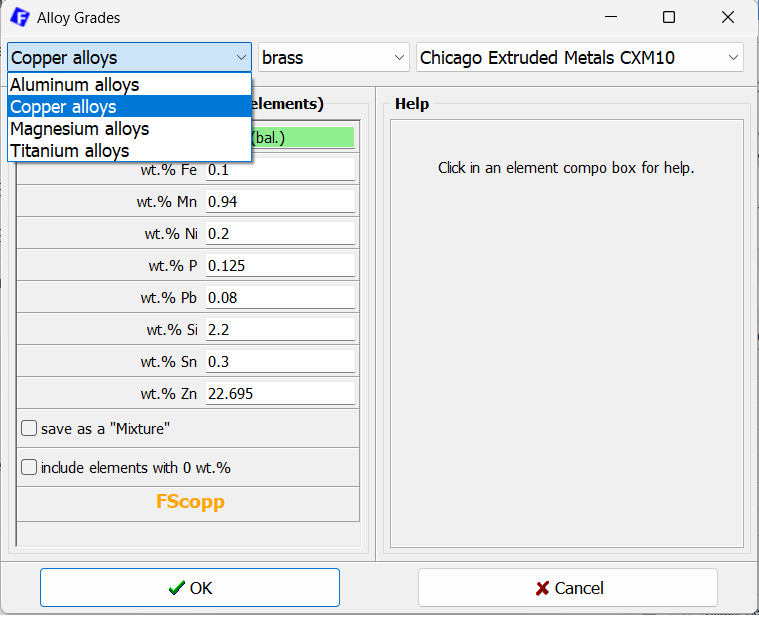
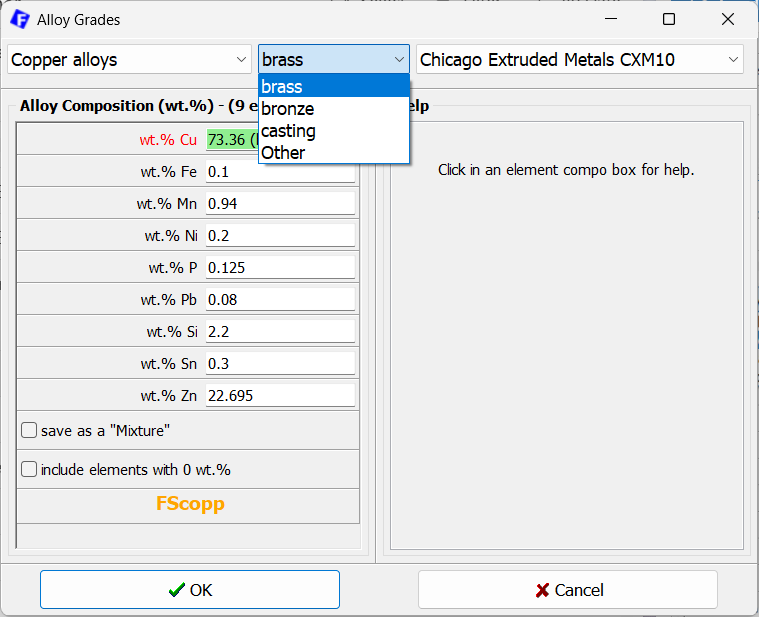
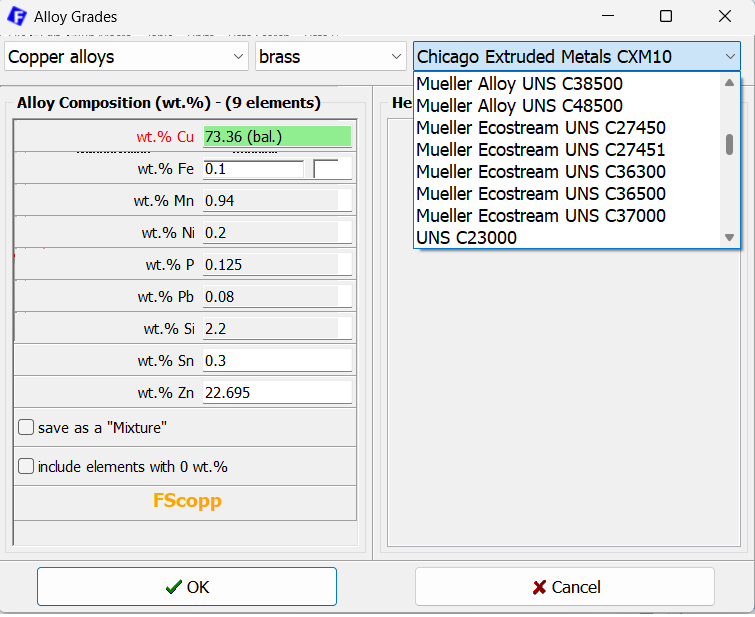
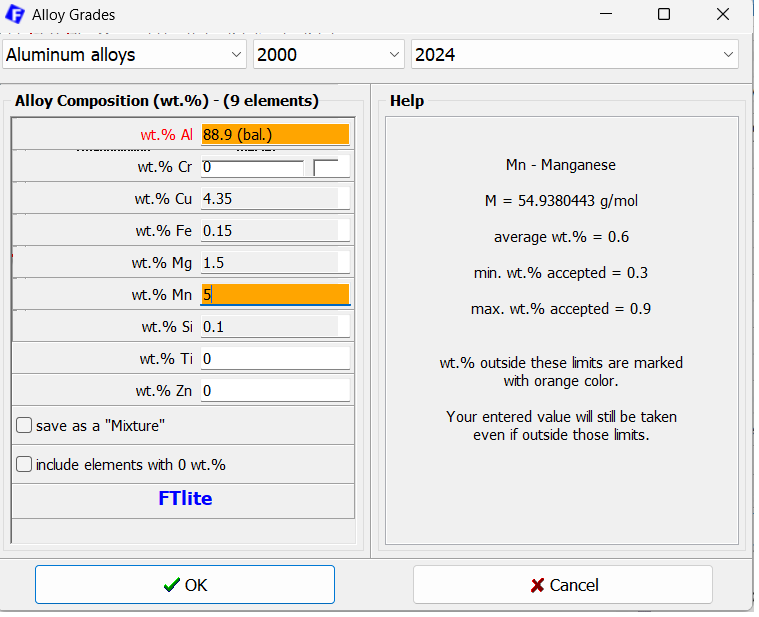
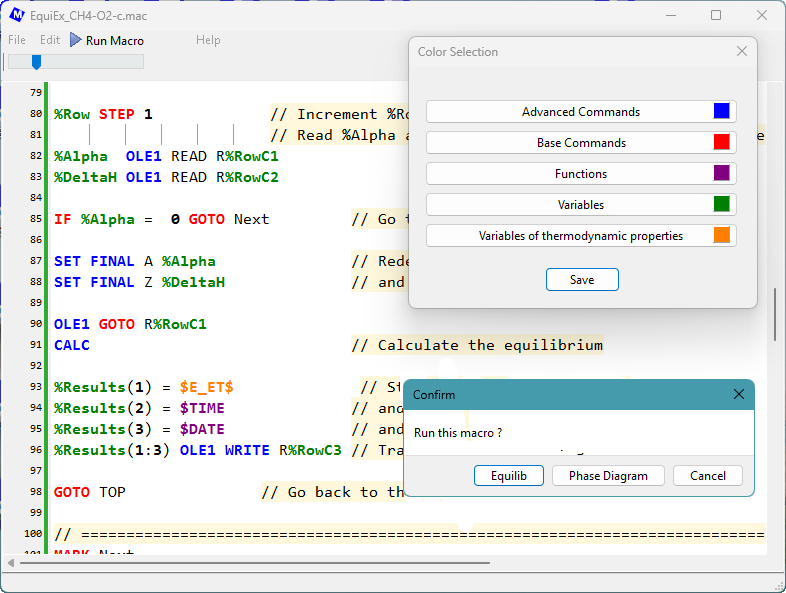
![]() Phase Diagram
Phase Diagram
The link
What's New in Phase Diagram has been updated and
gives a summary of the more important programming changes in
Phase Diagram that have appeared since FactSage 6.1 (2009) until now FactSage 8.4 (2023).

![]() OptiSage - Calphad Optimizer
OptiSage - Calphad Optimizer
User-friendly and robust Calphad optimizations using Calphad Optimizer in FactSage
in the
Calphad Journal.
3. Add-ons
Add-ons Menu for standalone installations
For detailed information refer to
Add-ons, apps and shortcuts in FactSage 8.4 .
In FactSage 8.4 the Add-ons Menu for standalone installations has been expanded with new process simulation packages:
FactFlow process simulator package
FactProSim process simulator package
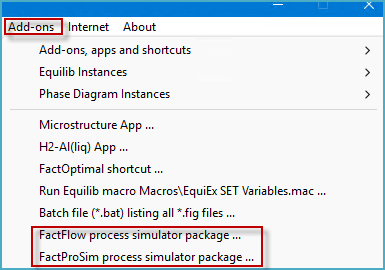
3.1 FactFlow process simulator package
FactFlow is a new FactSage Add-on developed by the CRCT team in Montreal to perform process simulation of pyrometallurgical processes.
Many FactSage customers have reported their desire to perform series of complex equilibrium calculations using a graphical interface to maximize the user experience when it comes to streams handling and stream recycling.
- Pyrometallurgical process modeling using FactFlow.
- article in Calphad Journal, Volume 88, March 2025, 102772.
- FactFlow User Manual
- online manual 56 pages
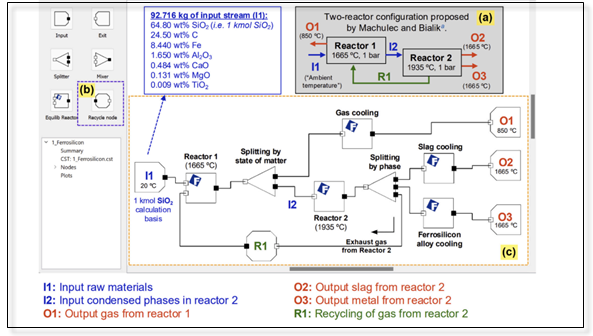 Ferrosilicon production via an electrical arc furnace.
Ferrosilicon production via an electrical arc furnace.
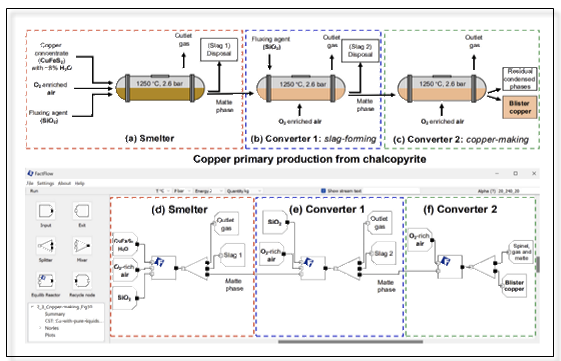
Primary production of copper from sulfides including recycling of waste
 Primary production of titanium using the Kroll process
Primary production of titanium using the Kroll process
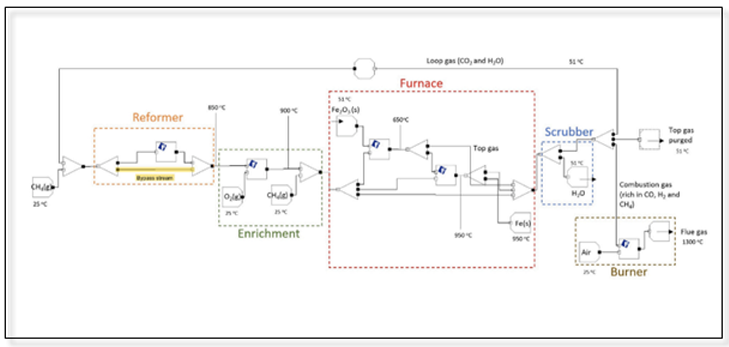
Simulation of the midrex process to account for
the partial substitution of methane by hydrogen.
3.2 FactProSim process simulator package
- FactProSim Manual (pdf file)
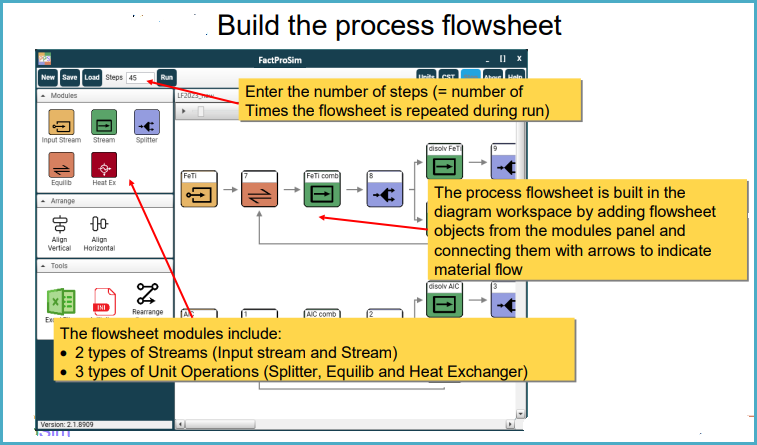
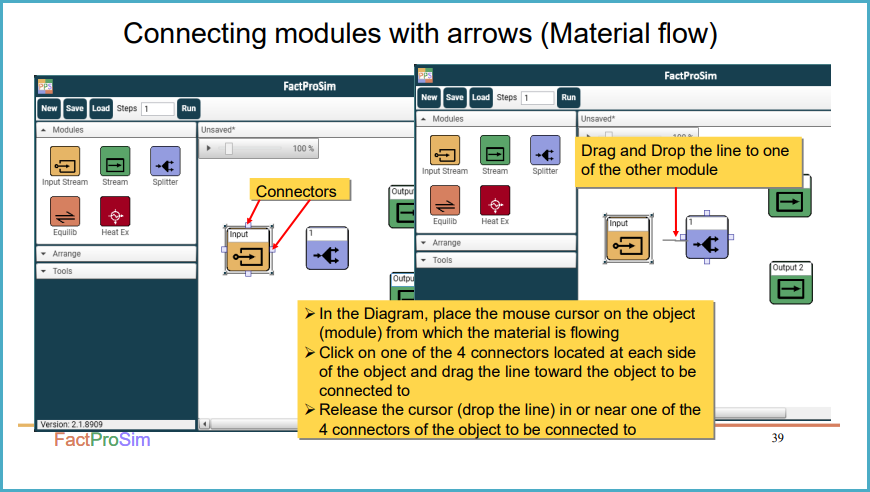
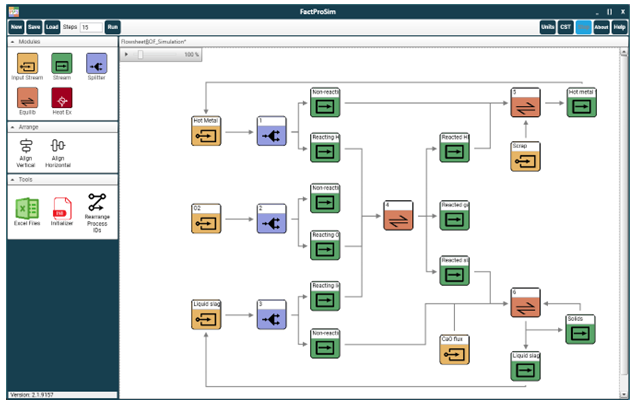
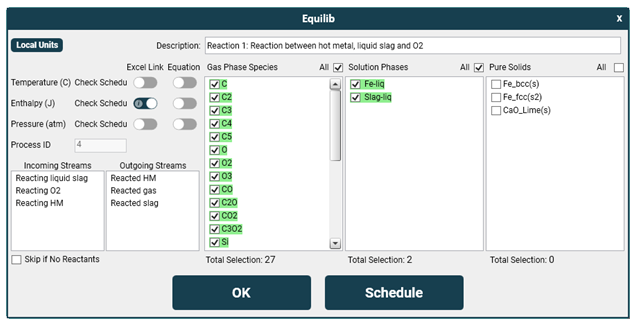
3.3 Process simulator databases
3.4 Why there are two process simulation packages
In particular, FactFlow:
While FactProSim:
FactProSim was initially developed for the Steelmaking Consortium at Seoul National University,
which comprises 14 industrial partners around the world. It has been employed by consortium members
to develop their own process simulations. Continuous enhancements and new functionalities, including
more user-friendly graphic outputs, will be introduced to enhance its versatility and flexibility,
and to meet users' needs.
The link
What's New in the Databases has been updated
and gives a summary of the more important programming changes in all the databases that have appeared
since FactSage 6.1 (2009) until now FactSage 8.4 (2025).
Import TDB databases
- this option, introduced in FactSage 8.3, enables you to import a Thermochemical Database (TDB) format database to the 'List of databases'
posted in the Data Search Window.
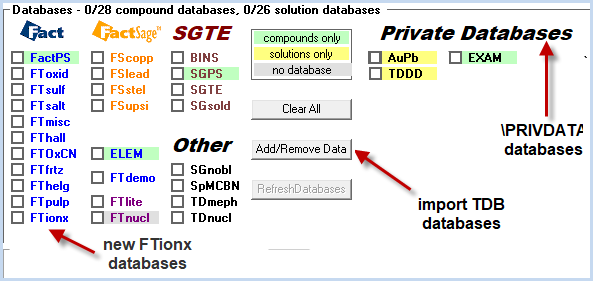
C7H10NBr, C7H10NCl, C7H13N2PF6, C8H15N2Cl, C8H15N3O3, C8H18NPF6, C9H14NBr, C9H14NCl, C9H14NPF6, C9H18N2SO3, C9H20NBF4, C9H20NBr, C9H20NCl,
C9H20NPF6, Ca2SnO4, Ca3SnSi2O9, CaSnO3, CaSnSiO5, Co11Ce24, Co13La, Co17Ce2, Co17Dy2, Co17Er2, Co17Gd2, Co17Ho2, Co17La20, Co17Lu2,
Co17Nd2, Co17Pr2, Co17Pr20, Co17Sm2, Co17Tb2, Co17Tm2, Co17Y2, Co17Yb2, Co19Ce5, Co19La5, Co19Nd5, Co19Pr5, Co19Sm5, Co2Ce, Co2Dy, Co2Er,
Co2Gd, Co2Ho, Co2Lu, Co2Nd, Co2Nd5, Co2Pr, Co2Pr5, Co2Sc, Co2Sm, Co2Sm5, Co2Tb, Co2Tm, Co2Y, Co2Yb, Co3Ce, Co3Dy, Co3Dy4, Co3Er, Co3Er4,
Co3Gd, Co3Gd4, Co3Ho, Co3Ho4, Co3La2, Co3Lu, Co3Lu4, Co3Nd, Co3Nd2, Co3Nd4, Co3Pr, Co3Pr4, Co3Sm, Co3Tb, Co3Tb4, Co3Tm, Co3Tm4, Co3Y,
Co3Y2, Co3Y4, Co3Yb, Co5Ce, Co5Dy, Co5Er, Co5Gd, Co5Ho, Co5La, Co5Nd, Co5Pr, Co5Sm, Co5Tb, Co5Tm, Co5Y, Co5Y8, Co7Ce2, Co7Dy12, Co7Dy2,
Co7Er12, Co7Er2, Co7Gd2, Co7Ho12, Co7Ho2, Co7La2, Co7Nd2, Co7Pr2, Co7Sm2, Co7Tb12, Co7Tb2, Co7Tm2, Co7Y2, Co7Y6, CoDy3, CoEr3, CoGd3,
CoHo3, CoLa3, CoLu3, CoNd3, CoPr3, CoSc, CoSc2, CoSc3, CoSm3, CoTb3, CoY, CoY3, Fe4Si2Sn7O16, Gd12Co7, K2Cr2O7, K2Fe12O19, K2FeO2,
K2FeSi3O8, K2FeSi5O12, K2FeSiO4, K2Hg3Cl8, K2HgCl4, K2Mo2O7, K2MoO4, K2S2O7, K3Na(MoO4)2, K4Fe4Si3O14, K4FeO3, KFe11O17, KFeSi2O6,
KFeSi3O8, KFeSiO4, KHg7Cl15, KHgCl3, Mg2SnO4, MgSnO3, Na14Zr2Si10O31, Na2Cr2O7, Na2HgCl4, Na2Mo2O7, Na2S2O7, Na2ZrO3, Na2ZrSi2O7,
Na2ZrSi4O11, Na2ZrSiO5, Na3ClMoO4, Na4Zr2Si3O12, Sn3O4, Zn2SnO4.
AlB2, AlB12, Al4C3, Al3BC, Al8C7B4,
K2CrO4, K2PbCl4, KPb2Cl5, Hg2Cl2, Na2MoO4, Na2CrO4, PbCl2.
The FToxid databases contain data for pure oxides and oxide solutions
of over 20 elements as well as for dilute solutions of S, SO4, PO4, H2O/OH, CO3, F, Cl and I
in the molten (slag) phase.
FToxid 8.4
is included in the FACT 8.4 package of databases.
Complete details on FToxid 8.4 including all the phase diagrams are given in the updated Documentation in the FactSage Main Menu Window.
K2O-FeO-Fe2O3-Al2O3-SiO2
SnO-SnO2 + MgO-CaO-FeO-Fe2O3-Al2O3-SiO2, SnO-SnO2-SiO2-ZnO, SnO2-ZrO2-TiO2
ZrO2-Na2O-CaO-Al2O3-SiO2
(Zr,Ti,Sn)O2 orthorhombic solution and Sn-spinel
Nepheline (KFeSi3O8 added); Leucite (KFeSi2O6 added); high-T Kalsilite (KFeSiO4 added);
high-T and low-T KAlO2-K2MgSiO4 solutions (KFeO2 added); Rutile and Corundum (SnO2 added);
cubic, tetragonal amd monoclinic ZrO2 (SnO2 and TiO2 added)
FTsulf 8.4 has been refreshed and is included in the
FACT 8.4 package of databases.
Li, Na, K, Rb, Cs, Mg, Ca, Sr, Ba, Mn, Al, Fe(II), Fe(III), Co, Ni, Zn, Pb, La, Ce, Th,
U(III), U(IV), Pu(III), Pu(IV), Cr(II), Cr(III), Mo(V), Hg, Hg2
New components Sr and Cs have been added, and the interaction parameter C-Ti has been changed.
The new database FTionx is devoted to ionic organics systems ("ionx" stands for "ionics").
Currently, there are only "ionic liquid" compounds (also referred to as "room temperature molten salts").
Ionic liquids have a low temperature of fusion (with a higher limit usually set arbitrarily to 100C), and consist of organic cations (which are large and asymmetric), and organic or inorganic anions.
Work is in progress on Deep Eutectic Solvent (DES) systems.
[C3MIm], [C4MIm], [C3MPip],
[C3MPy], [C3MPyrr], [C4MPyrr], [C2Py], [C4Py]
Cl, Br, BF4, NO3, CH3SO3, PF6.
FTionx is included in the FACT 8.4 package of databases.
Complete details on FTionx including all the phase diagrams
are given in 'Documentation' in the FactSage Main Menu Window.
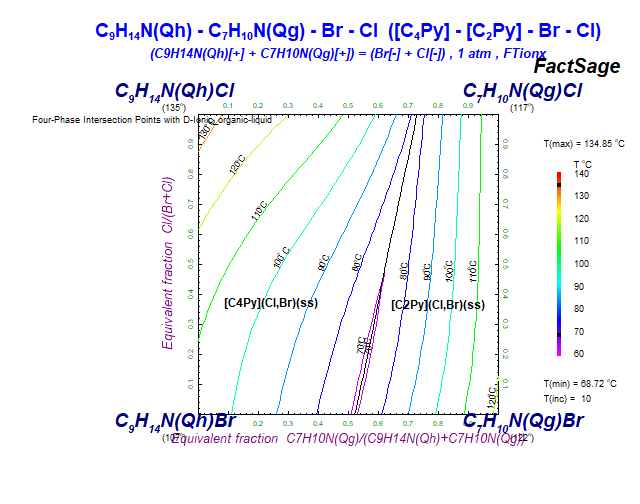
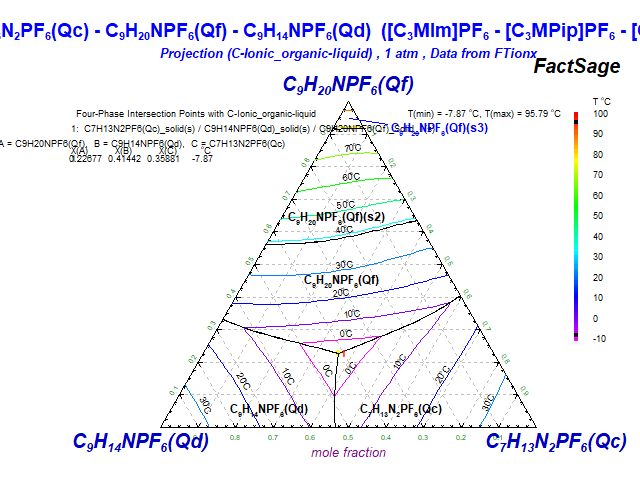
FTlite is designed for thermodynamic and phase equilibrium calculations involving
Al alloys, Mg alloys and Ti alloys.
It can also be used to perform calculations involving mixtures of Li-Na-KMg-Ca-Sr-Ba
with several other elements.
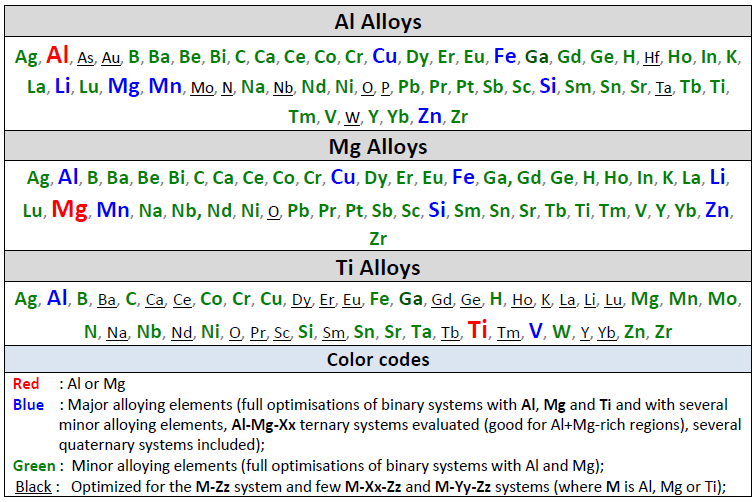

FTlite 8.4 binary assessments
full size
FScopp is designed for thermodynamic and phase equilibrium calculations involving Cu alloys.
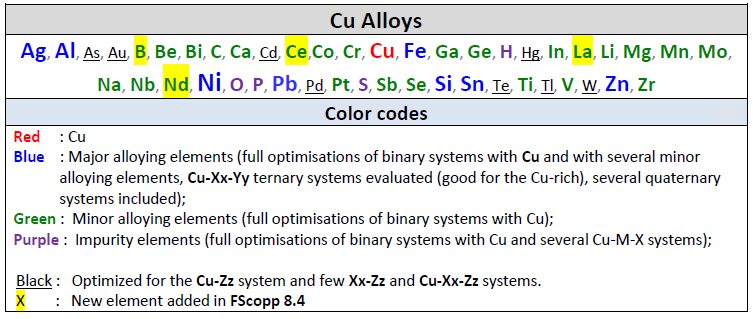
In FScopp 8.4 a total of 685 binary systems (603 in 8.3) have been evaluated,
for most of them over the entire range of composition and for all stable phases.
A matrix of assessed binary systems is shown here for the major and minor alloying elements of Cu-alloys.
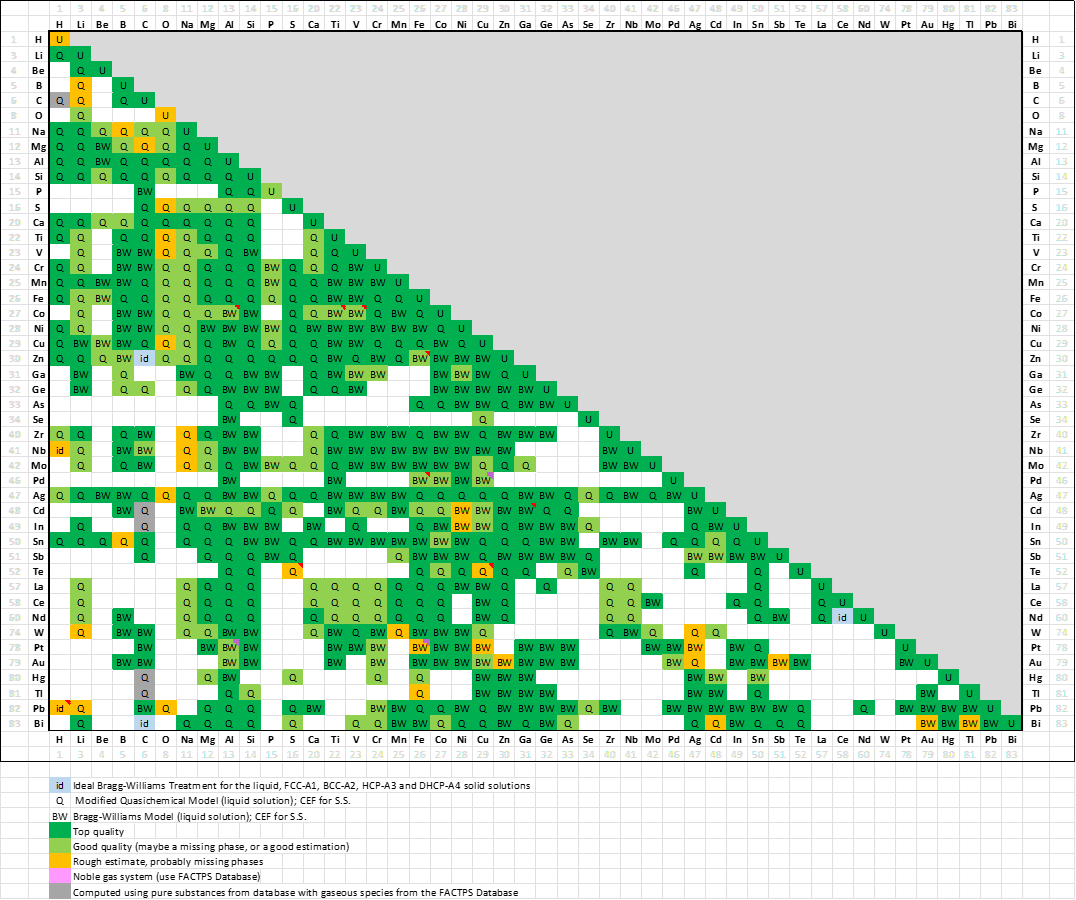
FScopp 8.4 binary assessments
full size
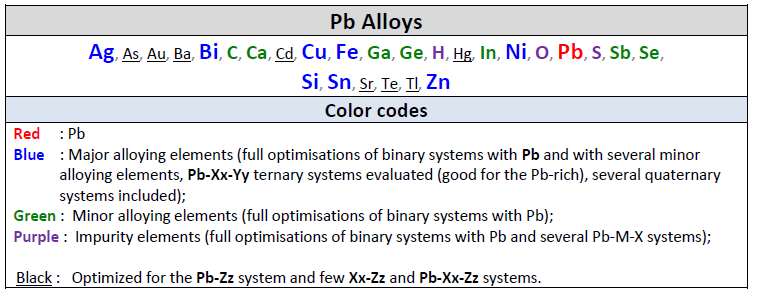
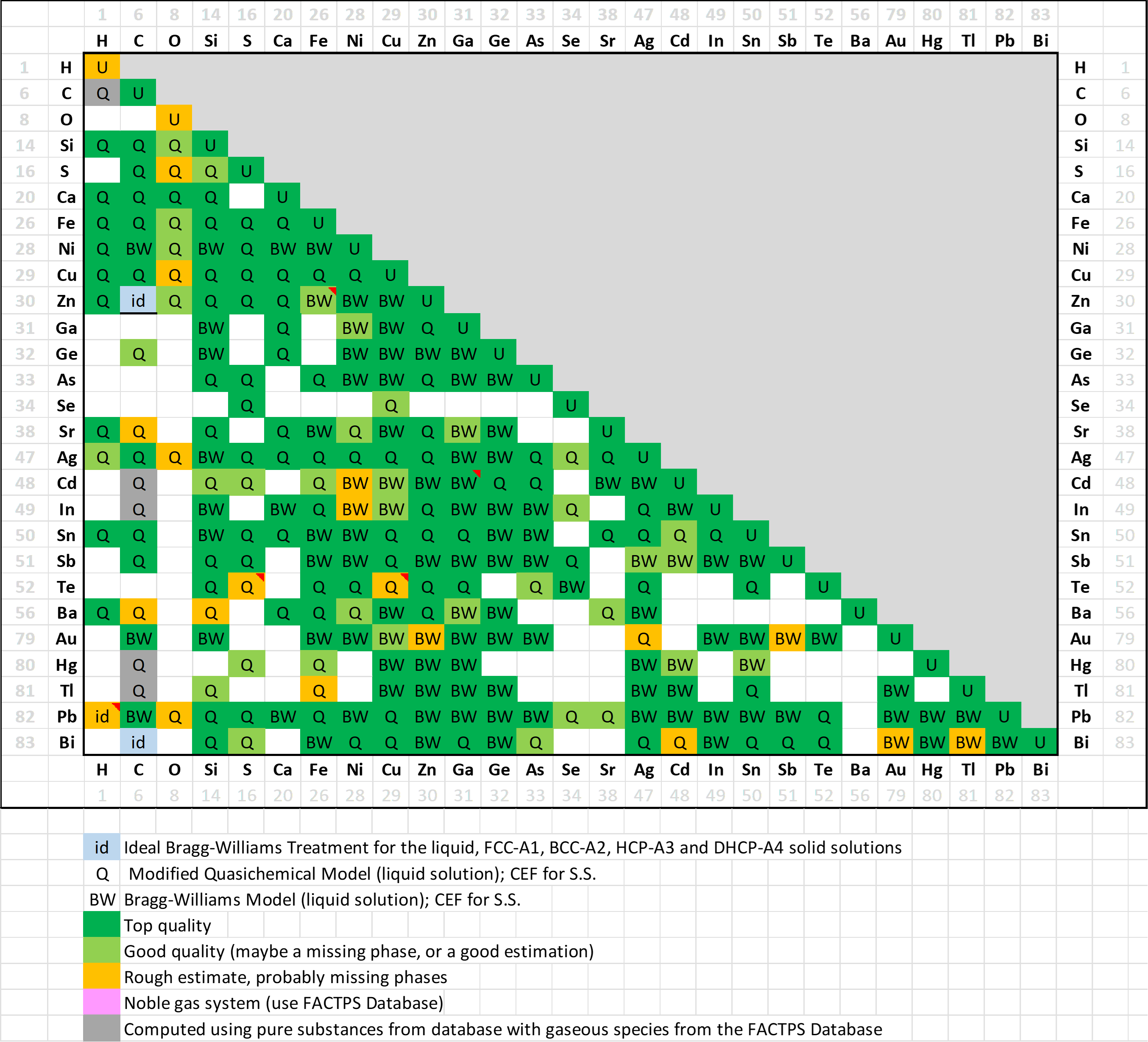
FSlead 8.4 binary assessments
full size
FSstel covers a wide range of commercial grade carbon steels and stainless steels, and new high advanced steels under development.
Al, B, Bi, C, Ca, Co, Cr, Cu, Fe, H, Hf, Mg, Mn, Mo, N, O, Nb, Ni, P, Pb, S, Sb, Si, Sn, Ta, Ti, V, W, Zn, Zr,
RE (Sc, Y, La, Ce, Pr, Nd, Sm, Eu, Gd, Tb, Dy, Ho, Er, Tm, Yb, Lu)
(a) Binary systems
Fe-Mo system: change of Mu_phase
Co-Nb system: replacement of CONB_lambda phase with Laves_C15, and
replacement of CONB_Mu phase with Mu_phase
Nb-Ni system: replacement of Nb6Ni7 phase with Mu_phase
Fe-Nb system: update of Mu_phase, Laves_C14, liquid phase
Ni-Ta system: update of Mu_phase
Fe-Ta system: update of Mu_phase
Fe-Mo-Ni system: update of Mu_phase
Co-Mo-Ni system: update of Mu_phase
Co-Cr-Mn system: update of Sigma, High_Sigma, Cub_A13, HCP
Cr-Mn-Ni system: update of BCC, FCC, Liquid
Co-Cr-Fe system: update of BCC
Co-Fe-Mn system: update of CBCC
Co-Cr-Ni system: update of Sigma, FCC, BCC, Liquid, P_phase
Fe-Ni-Ta system: update of Mu_phase, Liquid, others.
Co-Fe-Nb system: update of Mu_phase, Liquid
Cr-Nb-Ni system: update of Mu_phase, Liquid
Fe-Nb-Ni system: update Mu_phase, Liquid
Co-Cr-Fe-Mn system: high-Sigma solution containing Co
Al-V-H, Co-V-H, Fe-V-H, and Ni-V-H systems
C, N and H are added to these ordered phases
Fe-P-X ternary system: update for Fe3P in Me3P solid solution
Cu-O system: update of oxygen solubility in liquid Cu
Oxygen containing system: oxygen solubility in FCC and BCC solutions: change
of the solubility limits of oxygen in the solid solutions (max. 10 mol %)
Ni-P-S system: addition of NiPS3 compound
Cr-Ni system: small modification of liquid phase
Co-Cr system: small modification of liquid phase
Cr-Ta system: small modification of liquid phase
Cr-Ti system: correction of Laves_C14 and C36 (remove C-TiCr2 phase and combine it to C14)
The SGTE(2024) database is new and represents a significant update and revision of the previous
SGTE(2022) alloy database.
Ag, Al, Am, As, Au, B, Ba, Be, Bi, C, Ca, Cd, Ce, Co, Cr, Cs, Cu, Dy, Er, Eu, Fe, Ga, Gd, Ge, H, Hf, Hg, Ho, In, Ir, K, La, Li, Lu, Mg, Mn, Mo, N, Na, Nb, Nd, Ni, Np, O, Os, P, Pa, Pb, Pd, Pr, Pt, Pu, Rb, Re, Rh, Ru, S, Sb, Sc, Se, Si, Sm, Sn, Sr, Ta, Tb, Tc, Te, Th, Ti, Tl, Tm, U, V, W, Y, Yb, Zn, Zr
SpMCBN contains assessed thermodynamic parameters for binary and ternary alloys of high-temperature materials containing carbon, nitrogen, boron, and silicon. The alloys comprise the following systems:
Me1-Me2-C, Me1-Me2-N, Me1-Me2-B, Me1-Me2-Si, Me-C-N, Me-C-B, Me-C-Si, Me-N-B, Me-N-Si, Me-B-Si, Me1-Me2-Me3
B, C, N, Si with
Screenshot showing the summary of public databases in FactSage 8.4.
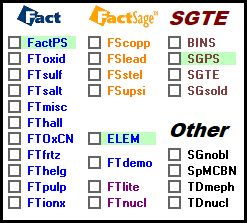
4. Previous FactSage Versions
The following are summaries of the more important programming changes in
Equilib, Phase Diagram, Macro Processing and Databases that have appeared in
FactSage 6.1 (2009), FactSage 6.2 (2010), FactSage 6.3 (2012), FactSage 6.4 (2013),
FactSage 7.0 (2015), FactSage 7.1 (2017), FactSage 7.2 (2018) , FactSage 7.3 (2019),
FactSage 8.0 (2020), FactSage 8.1 (2021), FactSage 8.2 (2022), FactSage 8.3 (2023) and FactSage 8.4 (2025).
What's New in FactSage:
FactSage 8.3 (2023)
FactSage 8.2 (2022)
FactSage 8.1 (2021)
FactSage 8.0 (2020)
FactSage 7.3 (2019)
FactSage 7.2 (2018)
FactSage 7.1 (2017)
FactSage 7.0 (2015)
FactSage 8.3 (2023)
FactSage 8.2 (2022)
FactSage 8.1 (2021)
FactSage 8.0 (2020)
FactSage 7.3 (2019)
FactSage 7.2 (2018)
FactSage 7.1 (2017)
FactSage 7.0 (2015)
